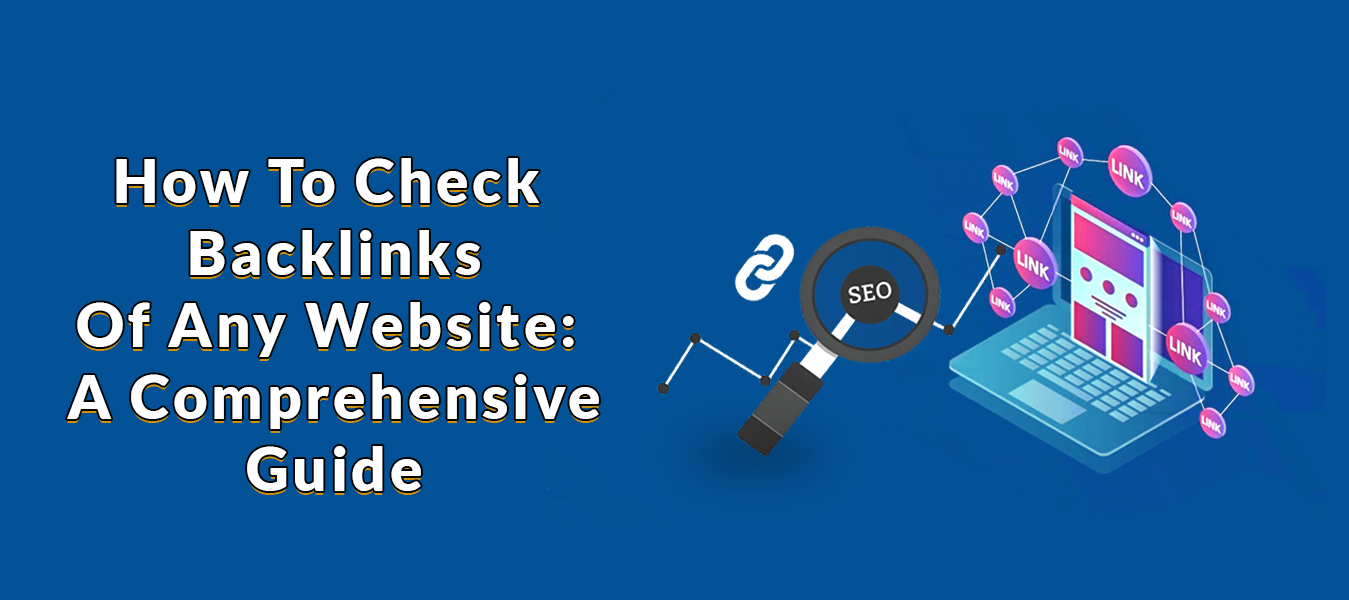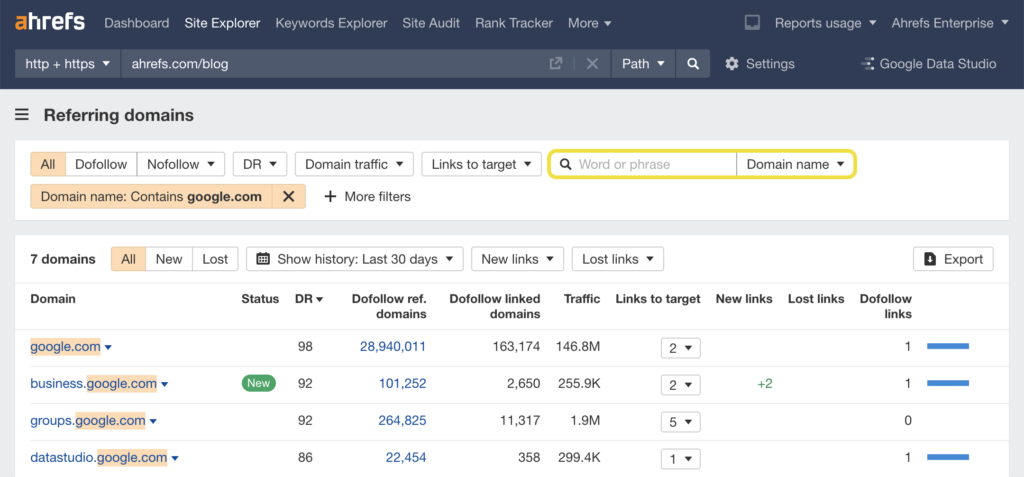To check backlinks of any website, use tools like Ahrefs or SEMrush. These tools offer detailed insights into the backlinks pointing to a website.
Backlinks are crucial for a website’s SEO. They show how other sites link to yours and indicate your site’s authority. Knowing how to check backlinks helps you understand your site’s strengths and weaknesses. It also reveals opportunities for improvement. In this guide, we will explain how to check backlinks easily.
We will cover the best tools and methods. By the end, you will know how to analyze backlinks like a pro. Let’s dive in and boost your site’s SEO performance.

Credit: www.semrush.com
Introduction To Backlinks
Backlinks are links from one website to another. They are critical for SEO. They help search engines understand a website’s credibility. The more quality backlinks a site has, the more trust it gains. This is why checking backlinks is essential for website owners and marketers.
Importance Of Backlinks
Backlinks act as votes of confidence. They show that other sites trust your content. This trust helps improve search engine rankings. Higher rankings lead to more traffic. More traffic means more opportunities for conversions.
Backlinks also help search engines discover new pages. When a site links to your page, search engines follow that link. This helps them index your new content faster. Faster indexing can lead to quicker visibility in search results.
Types Of Backlinks
Not all backlinks are equal. There are different types of backlinks. Do-follow and no-follow are the two main types. Do-follow backlinks pass on SEO value. No-follow backlinks do not. But both can still bring traffic to your site.
Editorial backlinks are highly valuable. These come from high-quality content. They are natural and trusted. Guest post backlinks are also important. They come from articles you write on other websites. These help build authority and reach new audiences.
Forum and comment backlinks are less valuable. They often come from user-generated content. They can still help with visibility and traffic. But they do not carry much SEO weight.

Credit: collaborator.pro
Benefits Of Checking Backlinks
Checking backlinks is crucial for any website’s success. It helps in understanding the website’s authority and its position in search engine rankings. By regularly monitoring backlinks, you can improve your site’s visibility and performance.
Seo Improvement
Backlinks play a significant role in SEO. High-quality backlinks can boost your search engine rankings. They signal to search engines that your content is valuable. This can lead to more organic traffic. Regularly checking backlinks ensures they are relevant and high-quality. Removing toxic backlinks can prevent penalties and keep your site healthy.
Competitor Analysis
Analyzing competitors’ backlinks offers valuable insights. You can discover where their backlinks come from. This helps in identifying new opportunities for your own site. By comparing backlink profiles, you can understand their strategies. This information can guide your own link-building efforts. Staying ahead of competitors is easier with regular backlink checks.
Tools For Checking Backlinks
Checking backlinks is important for understanding your website’s SEO health. Various tools can help you do this. Some are free, while others require a paid subscription. Using these tools can help you track your backlinks and improve your SEO strategy.
Free Tools
Several free tools allow you to check backlinks without spending money. These tools may have limitations, but they can still provide valuable insights.
- Google Search Console: This tool is free and provides a detailed view of your website’s backlinks. It’s easy to use and offers a variety of other SEO metrics.
- Ubersuggest: This tool offers a limited number of free searches per day. It provides a comprehensive backlink analysis for your website.
- Backlink Checker by Ahrefs: Ahrefs offers a free version of their backlink checker. It provides a limited number of backlinks and referring domains.
| Tool | Key Features | Limitations |
|---|---|---|
| Google Search Console | Detailed backlink data, free to use | Only for your own site |
| Ubersuggest | Comprehensive analysis, free daily searches | Limited searches per day |
| Backlink Checker by Ahrefs | Basic backlink data, free version available | Limited data in free version |
Paid Tools
Paid tools offer more detailed and extensive backlink data. They are more suitable for serious SEO enthusiasts and professionals.
- Ahrefs: This is one of the most popular SEO tools. It provides extensive backlink data and many other SEO metrics. Pricing starts at $99/month.
- SEMrush: SEMrush offers a comprehensive backlink analysis tool. It also provides a suite of other SEO tools. Pricing starts at $119.95/month.
- Majestic: Majestic specializes in backlink analysis. It offers detailed insights into your backlink profile. Pricing starts at $49.99/month.
| Tool | Key Features | Pricing |
|---|---|---|
| Ahrefs | Extensive backlink data, many SEO metrics | Starts at $99/month |
| SEMrush | Comprehensive backlink analysis, suite of SEO tools | Starts at $119.95/month |
| Majestic | Detailed backlink insights | Starts at $49.99/month |
Using Google Search Console
Using Google Search Console is a powerful way to check backlinks. It provides detailed information about your website’s performance. This includes insights into backlinks, which are crucial for your SEO strategy.
Setting Up Google Search Console
First, you need to set up Google Search Console. Follow these steps:
- Go to the Google Search Console website.
- Sign in using your Google account.
- Click on the “Start Now” button.
- Add your website’s URL in the provided field.
- Choose the verification method to prove ownership of the website.
- Complete the verification process as instructed.
Once verified, you can access various tools and reports. These help you monitor and maintain your website’s presence in Google Search results.
Finding Backlinks
To find backlinks using Google Search Console, follow these steps:
- Log in to your Google Search Console account.
- Select your website property.
- From the left-hand menu, click on the “Links” option.
In the Links section, you will see two main categories:
| Category | Description |
|---|---|
| External Links | Links from other websites pointing to yours. |
| Internal Links | Links within your website. |
Focus on the External Links section to check backlinks. Here, you will see:
- Top linked pages.
- Top linking sites.
- Top linking text.
Use this data to understand who is linking to your website. Analyze the quality and relevance of these backlinks. This helps you improve your SEO strategy and website performance.
Using Ahrefs
Using Ahrefs is one of the most effective ways to check backlinks for any website. Ahrefs offers powerful tools that help you analyze backlinks, identify link opportunities, and improve your SEO strategy. Let’s dive into how to use Ahrefs for checking backlinks.
Overview Of Ahrefs
Ahrefs is a comprehensive SEO toolset known for its extensive backlink database. It provides detailed insights into the backlink profile of any website. This makes it a favorite among SEO professionals. Ahrefs features a user-friendly interface that makes it easy to navigate and understand.
Some of the key features of Ahrefs include:
- Backlink Analysis: View and analyze all backlinks pointing to a website.
- Competitor Analysis: Discover your competitors’ backlinks and strategies.
- Site Explorer: A tool to explore the backlink profile, organic search traffic, and more.
- Rank Tracker: Monitor your keyword rankings over time.
Checking Backlinks With Ahrefs
Follow these simple steps to check backlinks using Ahrefs:
- Sign Up: Create an account on Ahrefs, and log in to the dashboard.
- Enter URL: In the Site Explorer, enter the URL of the website you want to analyze.
- Access Backlink Profile: Click on the “Backlinks” tab to view the backlink profile.
- Filter Results: Use the filters to sort backlinks by type, domain rating, anchor text, etc.
- Analyze Data: Examine the backlinks to understand their quality and relevance.
Ahrefs allows you to view detailed information about each backlink, such as:
| Metric | Description |
|---|---|
| Referring Domain | The domain from which the backlink originates. |
| Anchor Text | The clickable text in a hyperlink. |
| DR (Domain Rating) | A score that shows the strength of a website’s backlink profile. |
| UR (URL Rating) | A score that shows the strength of a target URL’s backlink profile. |
By analyzing this data, you can identify high-quality backlinks and potential link-building opportunities. This can help improve your website’s SEO performance significantly.
Using Semrush
SEMrush is a powerful tool for digital marketers. It helps you understand and improve your website’s SEO. One of its key features is checking backlinks. Backlinks are crucial for your site’s ranking in search engines. In this section, we’ll explore how to use SEMrush to analyze backlinks effectively.
Overview Of Semrush
SEMrush is a comprehensive SEO tool. It offers various features to enhance your online presence. Some of its key features include:
- Keyword Research
- Site Audit
- Position Tracking
- Backlink Analysis
Among these, the backlink analysis feature stands out. It provides detailed insights into your website’s backlinks. This helps you identify opportunities and potential issues.
Analyzing Backlinks With Semrush
Analyzing backlinks with SEMrush is straightforward. Follow these steps to get started:
- Log in to your SEMrush account.
- Navigate to the “Backlink Analytics” section.
- Enter the domain name you want to analyze.
- Click on “Analyze”.
SEMrush will generate a detailed report. This report includes:
- Total number of backlinks
- Referring domains
- Anchor texts
- Top linking sites
Use this information to improve your backlink strategy. Identify high-quality backlinks and build relationships with those sites. Remove or disavow low-quality backlinks that harm your SEO.
Here is an example of what the backlink analysis report might look like:
| Metric | Details |
|---|---|
| Total Backlinks | 5,000 |
| Referring Domains | 300 |
| Anchor Texts | Various |
| Top Linking Sites | example.com, sample.org |
With SEMrush, you can track your backlink growth over time. This helps you understand the effectiveness of your link-building efforts. Regular monitoring is key to maintaining a strong backlink profile.
Analyzing Backlink Quality
Understanding the quality of backlinks is crucial for any website’s SEO strategy. Not all backlinks are created equal. Some can boost your site’s authority, while others can harm it. This section will guide you through identifying high-quality backlinks and spotting toxic ones.
Identifying High-quality Backlinks
High-quality backlinks come from reputable, authoritative sites. These links can significantly improve your site’s SEO. Below are key indicators of high-quality backlinks:
- Domain Authority (DA): Links from sites with high DA are valuable.
- Relevancy: Links from sites related to your niche are more valuable.
- Anchor Text: Natural and relevant anchor text increases link quality.
Use tools like Moz or Ahrefs to check a site’s DA. Ensure the linking site is relevant to your content. Finally, analyze the anchor text to ensure it fits naturally within the context.
Spotting Toxic Backlinks
Toxic backlinks can harm your site’s SEO. Identifying and disavowing these links is essential. Here are some signs of toxic backlinks:
- Low Domain Authority: Links from low DA sites can be harmful.
- Spammy Sites: Links from spammy or unrelated sites are dangerous.
- Over-Optimized Anchor Text: Too many exact-match keywords can be a red flag.
Regularly monitor your backlinks using tools like Google Search Console or SEMrush. Look for links from low DA or spammy sites. Check the anchor text for over-optimization and take action if needed.

Credit: www.globexoutreach.com
Strategies For Building Backlinks
Building backlinks is crucial for improving search engine rankings. There are several strategies to effectively create backlinks for your website. Let’s explore some of the most effective techniques.
Content Creation
High-quality content attracts backlinks naturally. The key is to create content that is:
- Informative
- Engaging
- Original
Consider creating:
- How-to Guides: Detailed guides that help users solve problems.
- Listicles: Lists that offer valuable insights in a concise format.
- Case Studies: Real-life examples that showcase success stories.
High-quality content encourages other websites to link back to yours, improving your domain authority.
Outreach And Networking
Building relationships with influencers in your industry can significantly help in gaining backlinks. Here are some effective outreach methods:
| Method | Action |
|---|---|
| Guest Posting | Write articles for other blogs and include a link to your site. |
| Social Media Engagement | Interact with industry leaders on platforms like Twitter and LinkedIn. |
| Email Outreach | Send personalized emails to website owners requesting a backlink. |
Effective networking helps in establishing your authority and credibility in the industry.
Monitoring And Maintaining Backlinks
Monitoring and maintaining backlinks is crucial for your website’s SEO health. Regularly checking your backlinks helps ensure that your site remains authoritative and trusted by search engines. This section will guide you through the steps of monitoring and maintaining your backlinks effectively.
Regular Backlink Audits
Conducting regular backlink audits is essential for maintaining a healthy link profile. Use tools like Ahrefs, SEMrush, or Moz to track your backlinks. These tools provide detailed reports on your backlinks, including the source, anchor text, and link quality.
Here’s a simple checklist for your backlink audits:
- Download your backlink report from your preferred tool.
- Check for new backlinks added since your last audit.
- Identify any low-quality or spammy backlinks.
- Assess the anchor text used for your backlinks.
- Note any changes in the backlink status, such as removed or broken links.
By following this checklist, you can keep your backlink profile clean and robust.
Disavowing Bad Links
Disavowing bad links is a critical step in maintaining your site’s SEO health. Bad links can harm your site’s ranking and reputation. Google’s Disavow Tool helps you remove these harmful links from your backlink profile.
Follow these steps to disavow bad links:
- Identify the bad links using your backlink audit report.
- Create a text file listing all the URLs or domains you want to disavow.
- Format the file correctly, as specified by Google’s guidelines.
- Upload the file to Google’s Disavow Tool.
Here’s a sample format for your disavow file:
# Example: Disavow bad links http://spammydomain.com/badlink1 http://anotherbadlink.com
Regularly check for bad links and disavow them to keep your site healthy.
Conclusion And Best Practices
Understanding how to check backlinks of any website is crucial. It helps improve your website’s SEO performance. In this section, we will discuss a summary of key points. We will also cover tips for ongoing success.
Summary Of Key Points
Checking backlinks involves using tools and techniques. These tools help you see who links to your website. They also show the quality and relevance of those links. Here are the key steps:
- Use tools like Ahrefs, SEMrush, and Moz.
- Analyze the quality of backlinks.
- Identify and disavow toxic links.
- Monitor backlink growth and loss.
Using these tools helps you understand your website’s backlink profile. It also helps you find opportunities to improve your SEO.
Tips For Ongoing Success
Maintaining a healthy backlink profile requires ongoing effort. Here are some best practices to follow:
- Regularly audit your backlinks. Use tools to monitor and analyze new and lost backlinks.
- Focus on quality over quantity. Aim for backlinks from authoritative and relevant sites.
- Create valuable content. High-quality content attracts natural backlinks.
- Reach out for guest posts. Offer to write guest posts on relevant blogs.
- Disavow toxic links. Remove or disavow low-quality or spammy links.
- Stay updated with SEO trends. SEO is always evolving. Keep learning and adapting.
Following these tips will help you build a strong and healthy backlink profile. It will also boost your website’s SEO performance.
Frequently Asked Questions
What Are Backlinks In Seo?
Backlinks are incoming links from one website to another. They are crucial for SEO. They help search engines determine the credibility and relevance of a website.
Why Are Backlinks Important For Seo?
Backlinks are important because they boost a website’s authority. Search engines use them to judge the site’s popularity and trustworthiness. More quality backlinks improve search engine rankings.
How To Find Backlinks Of A Website?
You can find backlinks using tools like Ahrefs, Moz, or SEMrush. Enter the website’s URL in the tool. It will display a list of all backlinks pointing to that website.
Are All Backlinks Equally Valuable?
No, not all backlinks are equally valuable. High-quality backlinks from authoritative and relevant websites are more beneficial. Low-quality backlinks can harm your SEO.
Conclusion
Checking backlinks is crucial for improving your website’s SEO. Use tools like Ahrefs, Moz, or SEMrush. These tools give clear insights into your backlinks. Regularly monitor your backlinks for quality and relevance. Remove harmful backlinks to boost your site’s ranking.
Stay consistent in your efforts. Understand the importance of good backlinks. They help drive traffic and improve search engine visibility. Practice these tips for better SEO results. Happy backlink checking!




